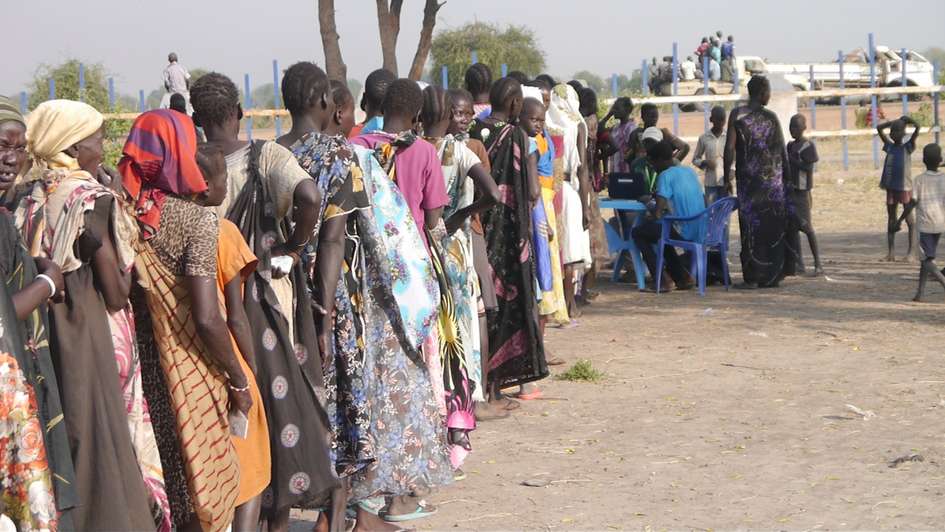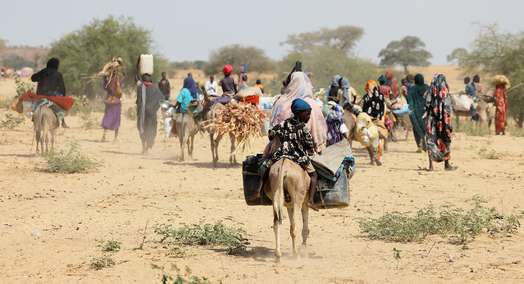Coping with armed conflict and hunger
More wars, more hunger?
We take a look at the complex relationship of hunger and armed conflicts

In 2014, more than 13 million people had to leave their home countries. The majority of them fled from armed conflicts in Syria, Afghanistan and Somalia. Countries with armed conflicts are often the worst-scoring countries in the Global Hunger Index (GHI) with regard to their hunger levels.
Armed conflicts undermine the food and nutrition security of people in many respects:
-
Flight and displacement mean that farmers can no longer tend their fields and regularly lose their entire possessions.
-
Roads and agricultural infrastructure are destroyed, and seeds, fertilisers and fuel are only available on a limited basis and at high prices.
-
Including and due to the limited security, trade also suffers.
-
As many foods can no longer be obtained or are simply too expensive, people eat less and, mostly, a more unbalanced diet. This leads to an insufficient nutrient supply, which particularly affects children. In addition, there is regularly neither clean drinking water nor sufficient medical provision, which further weakens the children especially.
Almost two-thirds of all children who suffer from chronic undernutrition are currently living in developing countries affected by armed conflicts. Twenty years ago it was less than half. At national level, military spending is frequently being increased and resources removed from development-related areas, such as agriculture, rural and social infrastructure. The conflict researcher Paul Collier calculated that, in a country with an armed conflict, economic growth reduces by an average of 2.3 per cent and that it takes 17 years to make up for this loss.
Hunger increases the risk of conflict
But is food and nutrition insecurity also a cause of violent conflict? The so-called ‘hunger riots’ as a reaction to food price increases in 2008 in Haiti or the Arab Spring uprisings in 2011 would suggest this.
However, the reality is more complex and the scarcity of food is usually only one of many reasons responsible for the outbreak of violent conflicts. This is particularly the case in countries that are heavily dependent on food imports.
Poverty is one of the main factors that leads to armed conflicts.
Weak governmental structures, stagnating economic growth, high youth unemployment and unequal access to income, land and natural resources create the foundations for the marginalisation of whole population groups and create a climate of hopelessness, making people more receptive to strategies of violence.
How are climate change and conflicts connected?
A much-debated relationship exists between the effects of climate change and conflicts. There are significant overlaps between countries that are particularly susceptible to climate-induced disasters and those with recurring armed conflicts, such as the extended region around the Horn of Africa (Ethiopia, Kenya, Somalia, Sudan and South Sudan) and the Sahel zone of West Africa. Extreme weather events like droughts and the resulting food shortages can give rise to or aggravate conflicts. Nevertheless, the ability or inability of governments to ensure the participation of all population groups in the decision-making process and to react adequately to humanitarian crises
How can the cycle of hunger and war be broken?
- In Africa south of the Sahara and in the Middle East, development is currently more than critical. Huge efforts are required so that hunger and war do not further reinforce each other here.
- In cases of threatening famines, humanitarian aid must correspond to those who need it most urgently – irrespective of political considerations.
- In doing this, long-term efforts to improve local food production must not be undermined.
- Strategies that help people to adapt to the effects of climate change and improve their nutritional status also contribute to conflict prevention.
- It is crucial, however, to tackle the underlying causes of hunger and armed conflicts, including poverty and increasing inequality, and to hold governments responsible for this.








